This site uses cookies to provide an optimized shopping experience. By using this site, you agree the use of cookies within our privacy policy.

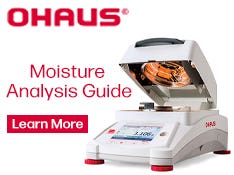
Ohaus Guide to Moisture Analysis
Learn the Basics of Moisture Analysis
Why is measuring moisture content important?
Moisture content analysis is a critical function of quality control in most production and laboratory facilities. Physical properties of a material such as weight, thermal expansion, amalgamation, electrical conductivity, and microbial activity can be adversely impacted by moisture. It is critical to measure the water content of substances in order to assess quality, adjust manufacturing processes, and ensure that products meet regulations and guidelines. For example, water content is important for the processing and handling of cosmetics, pharmaceuticals, food, personal care products, pulp and paper products, specialty chemicals, wastewater applications, etc.
How does a moisture analyzer work?
The Old Way: Direct Measurement
Direct measurements (such as Karl Fischer titration) address the presence of water itself, either through its removal or through chemical interaction. Thermogravimetric, or loss on drying (LOD) technique, measures the weight of a sample before and after a drying procedure and uses the weight delta to determine the percentage of moisture as the weight removed by the drying process in comparison to the initial weight of the sample.
Typically, this process is done in a drying oven with a balance to determine the initial and final weight of the sample, and uses a simple mathematical calculation to determine the moisture content ([initial weight - end weight]/initial weight). This process ordinarily takes several hours to complete and is vulnerable to user error.
The New Way: Moisture Analyzer
A moisture analyzer is an automated system that employs a microprocessor-controlled heating element and an analyzer all in one device to more efficiently measure the moisture content of a sample. The MB Series of moisture analyzers from OHAUS measure moisture via the loss on drying technique. These moisture analyzers define moisture as the loss of mass observed when the sample is heated and is based, in theory, on the vaporization of water during the drying process; this measurement does not distinguish weight loss of water from loss of volatile components or sample decomposition.
OHAUS moisture analyzers employ a heating element (e.g. a halogen bulb) that dries a sample by transferring energy using both radiation (the transmission of energy in the form of waves or particles through a medium - in this case, the sample) and conductive heat transfer, and a precision balance that monitors the weight loss during the drying process. The loss on drying technique is universally recognized as an efficient, reliable, and cost-effective method for determining moisture content.
Getting Started
Moisture analyzers relies on the user to set up the device correctly to achieve a particular result. There is no one-size-fits-all method for moisture analysis as the samples that can be and are used vary greatly and have a great deal of variance in both chemical and physical properties. It is up to you as the user to understand the particular substance you wish to test and develop a method that best fits your sample. In general there are two ways to use a moisture analyzer.
Targeting a Reference Value
First, if you already have a reference value (likely from a drying oven or other moisture determination process) you can orient your method development to target this value. As a starting point, we always recommend using the default values [automatic shut off value of 1mg / 60 seconds (A60), and the standard drying profile] and manipulating the temperature to find your optimal setting. If your moisture content result is too low, try raising the temperature; if it is too high, lower the temperature. Always inspect your sample once drying is complete to ensure that it has not burned or decomposed; if it has, lower your drying temperature.
Complex Samples with No Reference Value
If your sample is more complex, consult the OHAUS moisture guide for explanations of the various drying programs. If no reference value exists, then you may attempt to find a method that consistently dries your sample in the shortest amount of time (without burning or decomposing it). In this case we again recommend using the default values (A60 shut off, and standard drying profile) and manipulating the temperature to find your optimal setting. We recommend stating with a relatively low temperature (say 120°C) and raising (in small increments, say 5-10°C) as necessary to ensure your sample is thoroughly and efficiently dried but does not show signs of burning or decomposing. As a generic starting point the OHAUS moisture guide contains a set of sample methods for various samples. The OHAUS MB120 moisture analyzer is equipped with a feature called a temperature guide which helps determine the optimum drying temperature for a particular sample.
Tips for Best Practices
- Make sure your sample preparation is consistent and that the maximum surface area of the sample is exposed. If grinding or mashing is required, ensure that this is done using a consistent method that does not expose the sample to heat. Make sure the sample is evenly distributed and is not clumped in a way that would prevent energy from penetrating the sample and drying thoroughly.
- Allow adequate cooling between measurements. If the machine is still very hot from the previous run, it may affect the initial weight reading of the sample and cause inaccuracy in final percentage moisture content (%MC).
- Keep the starting weight for test material consistent. Since the final reading (weight) is a factor of the drying process, consistent starting weight will minimize differences due to physical parameters of sample introduction and drying profile.
- When possible, try to control the laboratory environment. For extremely sensitive samples or for cases where sensitivity in reading is critical, consider working in an environmental chamber where temperature and humidity are tightly controlled. In general, it is best to set up the instrument in an area free of windows to minimize exposure to temperature extremes, drafts, and other environmental conditions.
Product Comparison Chart
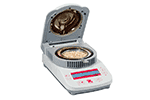

MB23 AM
Capacity: 110 g
Readability: 0.1%/0.01 g
Repeatability (Std Dev) (g): 0.3% (3 g sample); 0.2% (10 g sample)
Interface: Bidirectional RS-232
Temperature Range: 50 °C to 160 °C (in 5 °C increments)/122 °F to 320 °F
Power: 100 to 240 VAC, 50/60 Hz
Operating Temperature Range: 5 °C to 40 °C /41 °F to 104 °F
Display Type: Backlit LCD
Display Results: % moisture or % solids or weight (g), temperature, time
Pan Size: 3.5 in./90 mm
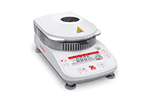

MB27 AM
Capacity: 90 g
Readability: 0.01%/0.001 g
Repeatability (Std Dev) (g): 0.2% (3 g sample); 0.05% (10 g sample)
Interface: Bidirectional RS-232
Temperature Range: 50 °C to 160 °C (in 5 °C increments)/122 °F to 320 °F
Power: 100 to 240 VAC, 50/60 Hz
Operating Temperature Range: 5 °C to 40 °C /41 °F to 104 °F
Display Type: Backlit LCD
Display Results: %moisture or %solids or weight (g), temperature, time
Pan Size: 3.5 in./90 mm
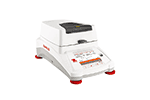

MB90
Capacity: 90 g
Readability: 0.01%/0.001 g
Repeatability (Std Dev) (g): 0.18% (3 g sample); 0.02% (10 g sample)
Interface: RS232, USB Host, USB Device
Temperature Range: 40 °C to 200 °C/104 °F to 392 °F
Power: 120 or 240 VAC, 50/60 Hz
Operating Temperature Range: 10 °C to 40 °C /50 °F to 104 °F
Display Type: 4.3 in./109 mm, QVGA, TFT touch screen
Display Results: %moisture, %solids, %regain, time, temperature, weight, method name, drying curve, statistics
Pan Size: 3.5 in./90 mm
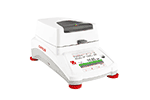

MB120
Capacity: 120 g
Readability: 0.01%/0.001 g
Repeatability (Std Dev) (g): 0.05% (3 g sample); 0.015% (10 g sample)
Interface: RS232, USB Host, USB Device
Temperature Range: 40 °C to 230 °C/104 °F to 446 °F
Power: 120 or 240 VAC, 50/60 Hz
Operating Temperature Range: 10 °C to 40 °C /50 °F to 104 °F
Display Type: 4.3 in./109 mm, QVGA, TFT touch screen
Display Results: %moisture, %solids, %regain, time, temperature, weight, method name, drying curve, statistics
Pan Size: 3.5 in./90 mm
Product Catalog
Product Videos
Product Assets and Documentation
Ohaus MB23 AM Moisture Analyzer Datasheet (pdf)
Ohaus MB23 AM Moisture Analyzer Manual (pdf)
Ohaus MB27 AM Moisture Analyzer Datasheet (pdf)
Ohaus MB27 AM Moisture Analyzer Manual (pdf)
Ohaus MB90 Moisture Analyzer Datasheet (pdf)
Ohaus MB90 Moisture Analyzer Manual (pdf)




